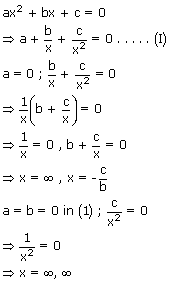1. The equation ax2 + bx + c = 0 (a ≠ 0) possesses exactly two roots But if the equation ax2 + bx + c = 0 is satisfied by more than two distinct values of 'x' then it is called an Identity and we have a = 0, b = 0, c = 0
2. The equation ax2 + bx + c = 0 has

Find the value of P for which the equation (R3 – 3R2 + 2R)x2 + (R3 – R)x + R3 + 3R2 + 2R = 0
3. Let α, β are the Roots of Quadratic Equation ax2 + bx + c = 0 then we have the identity in 'n'. Say a.Sn + b.Sn – 1 + c.Sn – 2 = 0 Where
α, β are Roots of 2x2 + 3x + 7 = 0, then 
